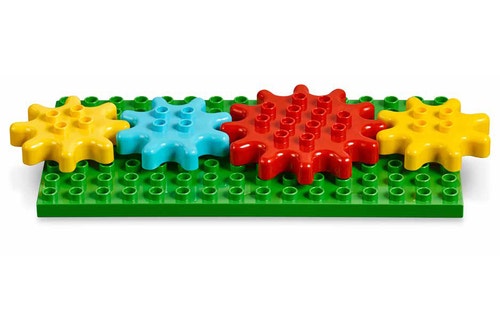Gears
In this lesson, students will learn about how gears work.

Prepare
Review this lesson plan and choose what you need from the Teacher Support box.
If necessary, pre-teach these related vocabulary words: gears, interlock.
Consider the abilities and backgrounds of all your students and decide when and how to introduce and differentiate lesson content, activities, or concepts.
The Science behind the Play: Gears are a rotating part of a machine with teeth that can interlock with another gear. The design of gears makes them able to transfer torque, or the force that causes the rotation.
Connect
Ask the students to find all of the elements that spin, and explain that spinning parts can be useful.
Tell the students gears are parts of a machine that are used to make other parts turn.
Have the students demonstrate how the spinning elements work, then ask them to line the gears up in a row and place them so that when they move one of the gears, all of the gears move.
Consider asking questions like:
- Which way do the gears turn?
- What happens when you interlock a large gear with a small gear?
- What happens when you interlock two gears of the same size?
Tell the students that you are going to read the beginning of a story about a group of people who are preparing STEAM Park for its daily visitors. You can show them the inspiration photo or use the figures to act out the scene.

- Read the following story aloud:
“We need a new gate to make the park look nice and to control how many people enter the park at a time,” said Parker, the park manager.
“I have some large gears in my garage. My dad brought them home from his factory and gave them to me. We could use them to build a new gate,” Teresa said.
“Great idea! I also have some bricks and other pieces we could use,” Parker said.
Tip: Interlocking gears in different ways causes them to move slower or faster and to turn clockwise or counterclockwise.
Construct
Show the students the inspiration photo for the Connect phase and ask them to identify which parts of the models move.
Ask them to build their own models of gates that open and close.
Contemplate
Ask the students to test their gates and make improvements.
Consider asking questions like:
- How do you make the gate open and close?
- Can a figure fit through the opening?
Continue
- Ask the students to create a double gate that opens from the left and right so that both sides can be opened at the same time to allow more people to move through at one time.
Did you notice?
Ask guiding questions to elicit students’ thinking and their decisions while ideating and building: What shapes are you using in your gate?
Observation Checklist
Review the learning objectives and success criteria addressed in this lesson (Teacher Support box).
Use the following checklist to observe students’ progress:
- Students can ask questions or make observations to figure out how to build a gate that will allow more people to move through at one time.
- Students can fully describe the improvements they have made to their new double gate and tell why those changes were necessary.
- Students can identify the two-dimensional (e.g., square, circle, rectangle) and three-dimensional shapes (e.g., cone, cube, cylinder) they used to build their gates.
- Students can compare the similarities and differences between shapes using informal language (e.g., number of sides, sides are the same length, etc.).
Teacher Support
Students will:
- Interlock gears
- Make the gears turn
NGSS K-2-ETS1-1. Ask questions, make observations, and gather information about a situation people want to change to define a simple problem that can be solved through the development of a new or improved object or tool.
Extension:
CCSS.MATH.CONTENT.K.G.B.4 Analyze and compare two- and three-dimensional shapes, in different sizes and orientations, using informal language to describe their similarities, differences, parts (e.g., number of sides and vertices/"corners") and other attributes (e.g., having sides of equal length).